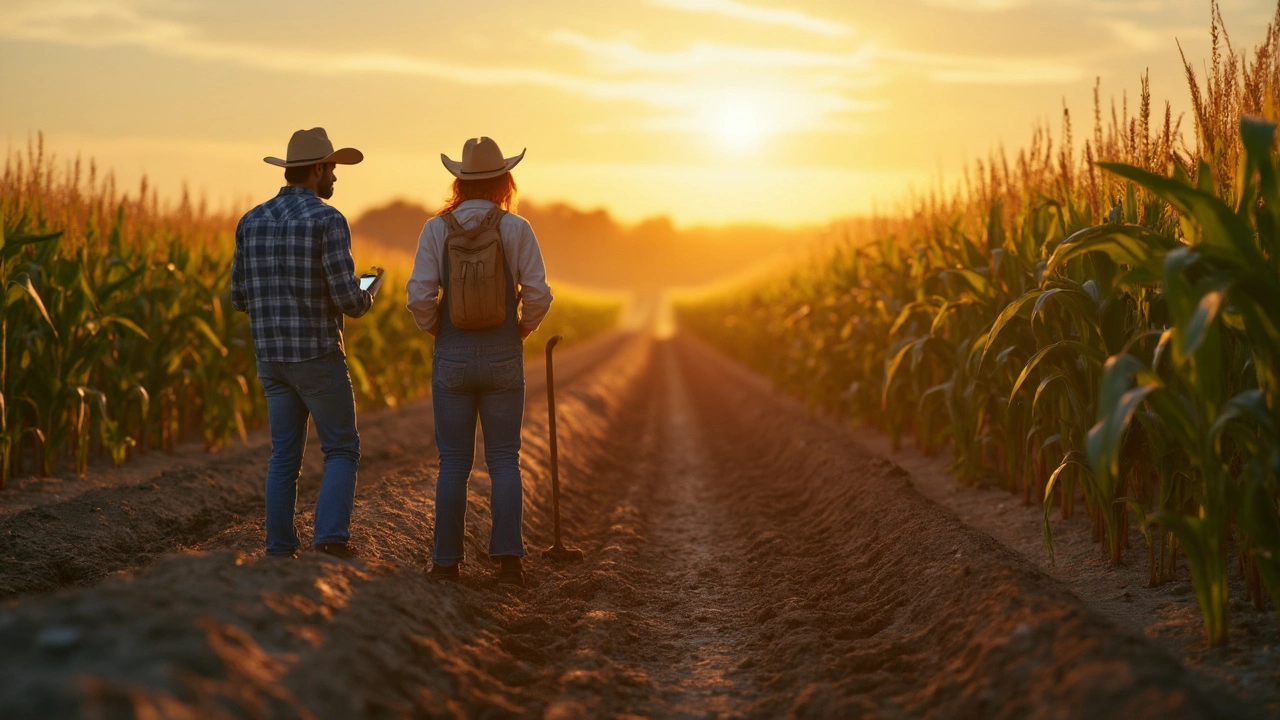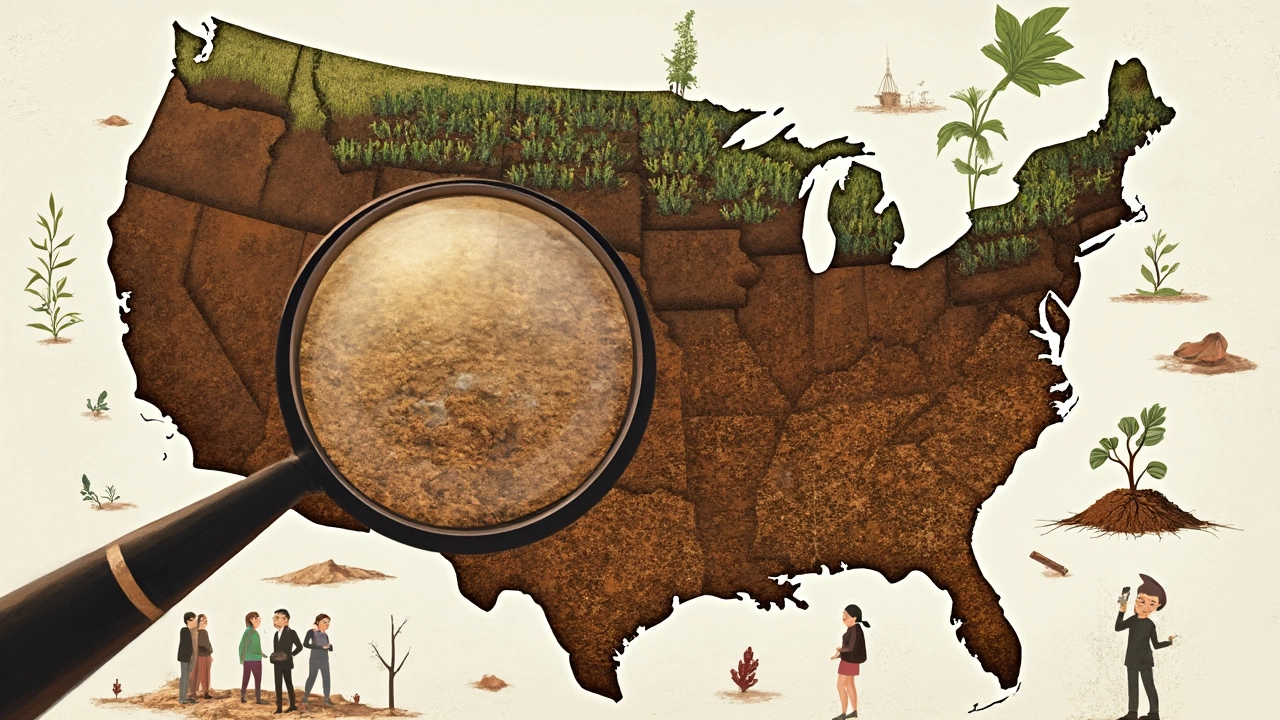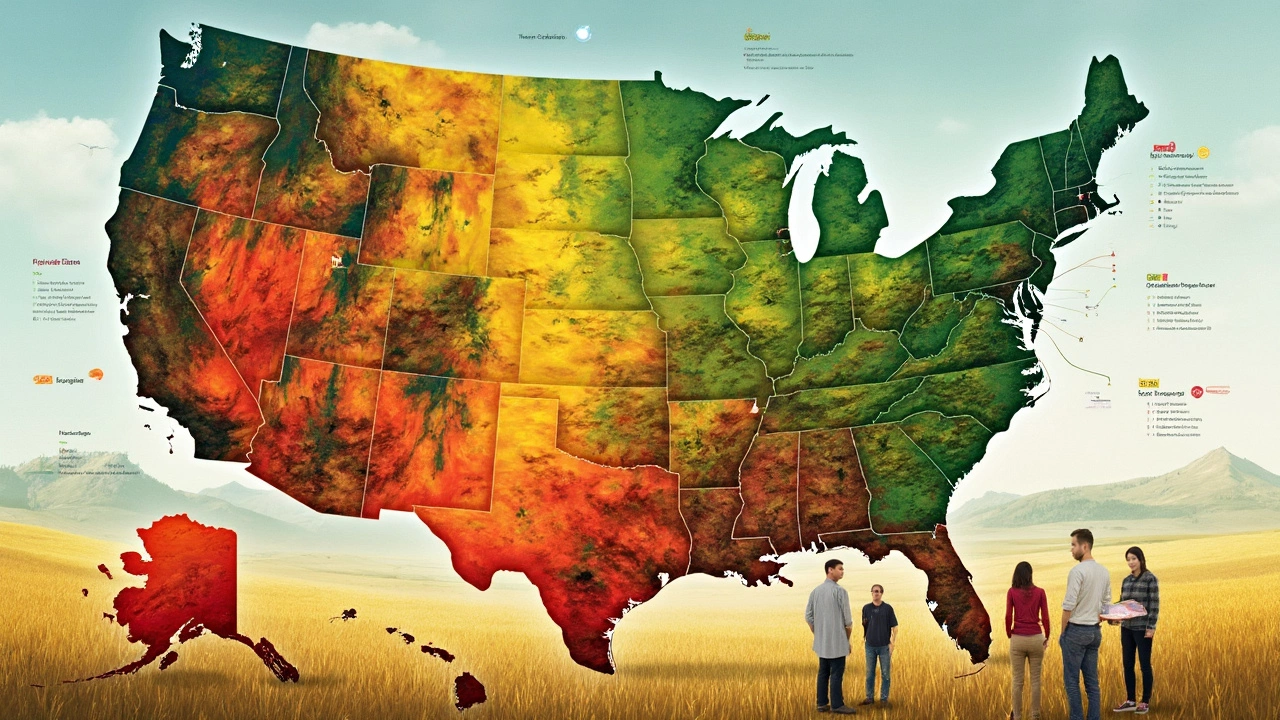If you’re looking to buy land, soil quality can make or break your plans—especially if farming or gardening is on the table. Forget flat stereotypes; not every patch of dirt is good dirt. Some states have rich, dark, crumbly soil that can turn seeds into full harvests without a ton of fertilizer.
So, which US state really has the best soil? There’s no contest: Iowa stands head and shoulders above the rest. Iowa is famous for its deep, black topsoil—called Mollisols. Farmers have nicknamed it ‘black gold’ for a reason: this soil grows corn and soybeans so efficiently that Iowa’s fields are legendary worldwide.
But it’s not just about natural fertility. The best soil holds water well, drains just enough, and has the right mix of nutrients, sand, silt, and clay. When you’re buying land, that balance is key. It decides if you’ll be sweating bullets planting crops, or watching things grow almost on autopilot.
- What Makes Soil 'the Best'?
- America’s Black Gold: The Iowa Advantage
- Other States with Hidden Soil Gems
- What to Check Before Buying Land
- Tips for Picking the Right State
What Makes Soil 'the Best'?
Not all dirt is created equal. When you’re sizing up land to buy, you’ll want to know exactly what makes soil stand out. The best soil isn’t just dark and crumbly. It’s loaded with minerals, has good structure, and lets roots spread easily.
The real science comes down to a few key factors:
- Best soil US headlines start with organic matter—organic means dead plants and animals broken down. This is what gives soil that black, nutrient-rich punch.
- Texture is next. The best stuff is usually a mix: not too much sand, not pure clay. Loam is the winner here. It holds moisture but drains fast enough to keep roots from drowning.
- pH level matters. Most crops want soil that’s a little on the neutral side, somewhere between 6 and 7. That’s where nutrients are most available.
- Good soil teems with life—think earthworms, bacteria, fungi. They eat up waste, break it down, and feed your plants naturally.
Want numbers? Check out this quick table that shows what great agricultural soil usually has:
| Property | Ideal Range |
|---|---|
| Organic Matter (%) | 3 to 6 |
| pH | 6.0 to 7.0 |
| Texture | Loam (mix of sand, silt, clay) |
| Drainage | Good, but not too fast |
| Depth of Topsoil (inches) | 8+ (Iowa often hits 12+) |
Ask any farmer—before you put your money down, get that soil tested. You want numbers, not promises. Soil tests are cheap and give you straight answers about what you’re really buying.
America’s Black Gold: The Iowa Advantage
Iowa doesn’t just have good farmland; it has some of the best soil on earth. We’re talking about Mollisols—this rich, black topsoil is what locals call “black gold.” Mollisols are loaded with organic matter, which helps crops grow fast and healthy. Around 30 million acres in Iowa sit on this powerhouse dirt, and that’s no small thing.
The numbers don’t lie. Iowa produces more corn than any other state. In 2023, it turned out over 2.5 billion bushels—that’s more than the total harvest of many whole countries. The magic comes from the deep topsoil, sometimes over 14 inches thick, which provides an almost perfect balance of nutrients and moisture.
What really sets Iowa apart isn’t just the sheer volume of crops, but the consistency. The best soil US allows for reliable yields, year after year, even when weather doesn’t cooperate. You won’t find yourself fighting constant drought or flooding here the way you might in other regions. That stability is gold for anyone buying land for farming.
- Mollisols hold water but drain well enough to keep roots happy.
- They're naturally high in nitrogen and other key nutrients, cutting down on fertilizer costs.
- This soil resists erosion better than sandy or clay-heavy soils.
If you care about re-sale value and kicking off a farm that actually turns a profit, Iowa’s soil quality is a smart bet. Even if farming sounds intimidating, demand for Iowa farmland keeps property values stable and rising. It’s not just buying dirt—it’s picking up a piece of a proven legacy.

Other States with Hidden Soil Gems
Iowa might steal the spotlight, but there are other states that quietly boast some top-notch dirt. Illinois is a classic—especially in the central and northern parts. If you drive through, black earth stretches as far as the eye can see. It’s not just pretty; University of Illinois soil maps show over half of the state has Mollisols, which make farming a moneymaker and home gardening a breeze.
Take Nebraska and Minnesota too. Nebraska’s eastern counties have thick layers of loamy soil, perfect for everything from corn to alfalfa. Minnesota gives you that same black topsoil, especially in the south and west. Don't overlook Ohio and Indiana; their Glaciated Region soils score big for water holding and strong yields on corn and soybeans.
Here’s a quick breakdown of these soil hotspots and what they’re known for:
| State | Main Soil Type | Best Crops | Region |
|---|---|---|---|
| Illinois | Mollisols | Corn, soybeans | Central & Northern |
| Nebraska | Loam, Mollisols | Corn, alfalfa | East |
| Minnesota | Mollisols | Corn, wheat | South & West |
| Ohio | Alfisols, Mollisols | Soybeans, corn | Glaciated Region |
| Indiana | Mollisols | Corn, soybeans | North & Central |
Why does this matter if you’re looking for land for sale? Rich soil points to better crop returns and less money spent on added fertilizers or soil amendments. If you spot a listing in any of these states, check the county and region. The right patch of ground can turn a good purchase into a great investment.
And if you hear locals rave about dark, crumbly, "black dirt"—that’s your cue to pay closer attention. Some of the best soil US options don’t shout; they just quietly outgrow the rest.
What to Check Before Buying Land
If you’re serious about getting land with the best soil US has to offer, don’t trust a real estate ad or a couple of pretty pictures. You need solid facts and numbers. Before you sign anything, here’s what you should be checking:
- Soil Type: Ask for a recent soil survey or get one yourself. The Soil Survey from the USDA is free online and will tell you if the area has Mollisols, Alfisols, or something less ideal. Mollisols are top-tier for crops.
- Soil Depth: Deep topsoil—like Iowa’s famous 12-18 inches—gives plants more room to grow roots and soak up nutrients.
- Drainage: Both waterlogged and bone-dry soil are a nightmare. See if the land floods easily or stays swampy after rain.
- pH and Nutrient Balance: A basic lab soil test costs about $20–$40 and tells you if you need to fix acidity or add anything.
- Previous Use and Chemicals: Find out if the land was ever hit with heavy pesticides, industrial dumping, or anything toxic. Old orchards, for example, might have lead or arsenic in the soil.
Feeling lost? You can use these places/resources for backup:
- USDA NRCS Web Soil Survey
- Local Cooperative Extension offices (usually at ag-focused state universities)
- County plat records for land history
Now, here’s a quick look at how some key stats can differ across famous farming states. Pay attention if yield numbers matter to you:
| State | Average Topsoil Depth (inches) | Typical Soil Type | Average Corn Yield (bu/acre) | Drainage |
|---|---|---|---|---|
| Iowa | 10–18 | Mollisols | 200–230 | Well-drained |
| Illinois | 8–15 | Mollisols | 210–230 | Mostly good, some wetlands |
| Nebraska | 6–14 | Andisols, Mollisols | 180–200 | Varies by region |
| California | 6–12 | Alfisols, Entisols | 185–210 | Needs irrigation |
So don’t just look at the state—look at the numbers. Even in states with great reputations, fields sitting just a county apart might vary a ton in yield or health. Scout the specifics before you put your money down.

Tips for Picking the Right State
When you’re actually in the market for land, a fancy view might distract you from what’s under your feet. The right state means better crops, healthier gardens, and less money thrown away on soil fixes. Here’s how you can zero in on the best spot for your plans, whether you’re growing soybeans or veggies for the family.
Start by looking at maps of soil types. The USDA’s Web Soil Survey (it’s free and super easy to use) will show you where Mollisols—the same stuff found in Iowa—spread across the Midwest. But don’t just trust the Internet; get a best soil US test kit, and check if the land’s pH, organic matter, and nutrients match your needs. Even in good states, land can be over-farmed or neglected.
Next, don’t ignore weather. Some spots in Nebraska, Illinois, and Indiana rival Iowa for soil, but can get hammered by drought or flooding. Look up rainfall averages and temperature swings in county ag reports before you buy. Table below shows some stats for top soil states:
| State | % Prime Farmland | Avg Topsoil Depth (inches) | Avg Corn Yield (bushels/acre) |
|---|---|---|---|
| Iowa | 60% | 10-12 | 200 |
| Illinois | 55% | 8-10 | 202 |
| Nebraska | 40% | 8-10 | 180 |
| Indiana | 45% | 8-9 | 195 |
Before you buy, always:
- Walk the land and dig into the dirt—real soil is crumbly and dark, not gritty or pale.
- Ask neighbors or farmers nearby what really grows well, and what struggles.
- Check the property’s flood history and how water drains after a heavy rain.
- Look up land use records so you’re not stuck with a buried EPA cleanup problem.
States like Iowa, Illinois, and Nebraska get most of the attention, but some counties in Minnesota and the Red River Valley (North Dakota) are just as good. Don’t be afraid to go off the beaten path; sometimes you’ll find cheaper land with top-grade dirt a few miles from the main farming hot spots.





